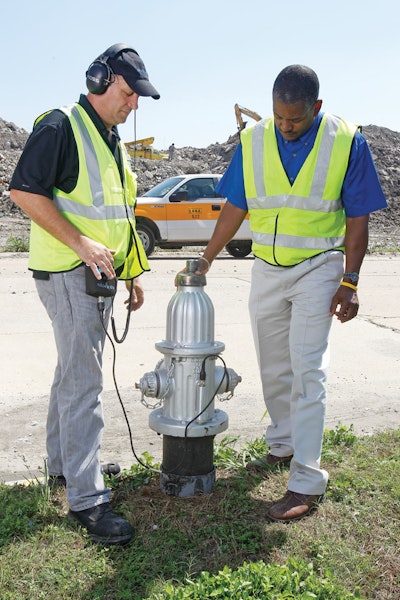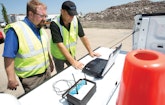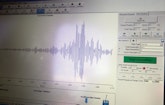
Interested in Inspection?
Get Inspection articles, news and videos right in your inbox! Sign up now.
Inspection + Get AlertsWhile Hurricane Katrina fades into the country’s memory, its aftermath is a daily reality for the Sewerage and Water Board of New Orleans (SWBNO).
The board is working with the Federal Emergency Management Agency (FEMA) on proposals for a major main replacement plan, while an army of repair crews work to isolate and eliminate leaks. Among their diagnostic tools is an acoustic technology that helps assess pipe degradation and locate leaks with precision.
Ongoing assessments by SWBNO staff indicate that the current condition of the mains is directly related to the flooding caused by Katrina, which struck in August 2005. “When the levees failed, it brought a flood of water through the city that tossed cars aside, tore houses from their foundations, and uprooted trees, which pulled up pipes along with their roots,” says Joe Becker, general superintendent.
“The city is like a flat-bottomed bowl, so when you fill it with eight, or 10, or even 16 feet of water, and it sits there for weeks, it depresses the soil, crushing waterlines and traumatizing every pipe joint.”
Maintaining pressure
During the hurricane and flood, a small contingent of SWBNO staff remained behind to face the crisis with a two-pronged operation. Drainage pumping stations continued to remove water from the city, although at that point floodwater entered through levee breaks as quickly as it was being pumped out. Rather than shut off the potable water, operators worked tirelessly to maintain water pressure through the leaking system to ensure that sewage and floodwater didn’t enter the lines.
“We needed to keep those pipes pressurized so that they remained potable,” says Becker. “Before the storm, we typically supplied 100 to 110 million gallons of water per day for 400,000 people. For three days straight, we were pumping more than 200 million gallons for a population as close to zero as we were ever going to get.”
The only bright spot: the west bank levees held, sparing 10 percent of the population and its water system. The city’s two water treatment plants also survived.
On the east bank, crews worked to valve off water mains to maintain pressure in the most-affected lines, traveling by skiff and any vehicle that could ply the floodwaters.
“We were driving crew trucks that rode high enough above water, and closing off the valves in the largest mains to isolate different line segments,” says Rudy August, chief of networks. “That helped us to keep up the pressure in the critical lines. The communication was spotty, and we had no precedent for this, so we were working almost on instinct, identifying and prioritizing the worst of the leaks.”
The situation worsened during the cleanup as hydrants were torn loose by backhoes removing debris, and home service connections were ruptured as buildings were demolished.
86,000 leaks
The floodwaters were quickly pumped out by the city’s 24 massive drainage pumping stations – combined capacity of 30 billion gallons per day. But six years later, the water system continues to suffer Katrina’s effects. As of this year, the board had repaired more than 86,000 water leaks, replaced more than 8.5 miles of water mains, installed 74 new valves, and repaired and inspected more than 14,000 hydrants.
Leaks repaired since the worst aftermath of the hurricane amounted to 75 million gallons per day. Yet the water hemorrhage continues. SWBNO is fully funded by ratepayers, although various state and federal agencies have provided opportunities for grants and other assistance to the city.
FEMA continues to play a major role in daily water system operations and has funded about $45 million in point repairs. Still, the city and SWBNO maintain that the damage caused by Katrina was so severe that wholesale line repair is the only way to revitalize the system. At issue now is how much of the system needs to be replaced and who pays.
FEMA is close to an agreement to fund replacement of some joint-to-joint line segments of about 1,000 feet each, provided that section has reported a specified number of leaks since Katrina. SWBNO is working to make the case that the flood caused more than half the damage to the east bank water distribution system and that the entire system should be replaced, at FEMA’s expense.
“Despite all the repairs completed over the last three to four years, we have not had much success in catching up on emerging leaks and point repairs,” says Becker. “We’re winning the daily battles, but I’m not sure about the war. We’re still putting out 125 million gallons of water a day at slightly reduced pressure, but for far fewer customers, so there’s still a significant water loss on the east bank.”
Dig and replace
Repairs are all dig-and-replace on small sections of pipe, largely involving joint removal and replacement and clamp repairs. Although the board has examined some trenchless repair options, proceeding with them would require an extensive financial commitment within a program to revitalize the overall system.
While making its case for line replacement, the board has also sought a more effective method for locating and repairing leaks. Various technologies and third-party leak detection contracts had yielded limited results. “We were getting a lot of dry holes,” says Becker. “With limited resources, we couldn’t afford to keep sending repair crews to investigate false leak reports.”
Not that leak detection in New Orleans is easy. The city has an extremely high water table, sometimes only a foot below the ground after a heavy rain. Utilities are buried at three to four feet, so most leaks empty into pressurized water surrounding the lines. Safety for leak-repair crews is paramount, as each excavation must be carefully dewatered and shored before entry.
“That isn’t a recent problem,” says Becker. “It’s been a challenge to locate leaks since we first pressurized the system over 100 years ago. If you see a leak on the surface, is it a leak from the potable water system, or just ground water bubbling up?” Many leaks are diverted into the sewage system or through utility conduits also surrounded by groundwater. With some sections of the city still sparsely inhabited, even surface leaks may remain unreported for up to a month.
Condition assessment
In late 2010, the board issued a new tender for a one-year pipe condition assessment contract, renewable for a second year. It selected Echologics Engineering, a subsidiary of Mueller Water Products. The company’s core technology is a proprietary acoustic-based leak detection system used to pinpoint leaks and assess the structural integrity of selected waterlines.
The company had impressed members of the board during a four-day pilot program in which Echologics technicians located water main leaks that totaled 75,000 to 100,000 gallons per day.
“They just went out and identified the exact locations of leaks on line segments by marking them with an X on the ground,” says Becker. “They were significantly successful. One problem we faced was that before then, we would fix one leak along a line segment, and then shortly after, the next-weakest point became the weakest point and we had a new leak surfacing a few yards away. The Echologics technology finds all of the leaks in the selected line segment, not just the worst ones.”
Besides helping to locate leaks, the assessment accurately reports the condition of the lines. That helps the board in making its case to FEMA and helps to assess the defects as either pre- or post-Katrina.
“We initially developed the product to sense the subtle sounds associated with leaks in plastic pipes, something that had evaded other technologies,” says Marc Bracken, vice president and general manager of Echologics. “The level of processing of the data we collect is also very sophisticated, so we can also detect leaks under backpressure from surrounding groundwater.”
The New Orleans contract provides three Echologics engineers which are available 24 hours a day. When a leak is suspected, the operators place two acoustic sensors on both ends of the suspected location. Typically, the sensors are placed 300 to 1,500 feet apart on distribution mains, and 2,400 feet apart on transmission mains.
“We clamp the sensors to either a valve or a hydrant for the best results,” says Bracken. “We know how fast the sound of a leak travels in water, so we calculate the time delays of the sounds between the two sensors. We crunch the data to calculate the specific location of the leak, then simply draw an X on the road to inform repair crews where to dig.
“If the leak is particularly large, we might check the line segment a second time on either side of the leak location for sister leaks.” While detecting leaks, the same technology also produces an accurate assessment of pipe degradation, which indicates wall thickness along the tested span and reports on the accuracy of inline district meters.
Cameras too invasive
“The city is using this non-invasive method for pipe inspection, considering the condition of some of the lines,” says Bracken. “Any time you send in a camera you stir up sediment and risk chipping off buildup. And, while the cameras may see large leaks, they can’t see small ones. For the amount of information a camera can gather on leaks and line condition, we can do it faster acoustically.”
The SWBNO prioritizes the areas it wants Echologics to analyze, but also gives the contractor freedom to proactively analyze other areas identified by the board as high-risk. In the first two weeks of the contract, the Echologics crew identified leaks totaling 358,000 gallons per day.
“The biggest leaks we’ve found are the ones that are diverted straight into the sewer,” says Bracken. “They never surface.” The SWBNO has also used a SmartBall acoustic sensor orb designed by Pure Technologies Ltd. Surrounded by a foam-rubber wrapper, the ball is dropped inside a line segment and records leak information as it rolls along the pipe, driven by water flow.
“The ball itself records the acoustic information,” says Becker. “You drop it in one part of the system and pick it up in another. It’s limited to transmission lines larger than 12 inches. You have to make sure the line segment is isolated and that you can pick up the ball on the other end, or else it can take a wrong turn. It has found some leaks for us, and it’s a viable product that we’re willing to use in the future. It’s an additional technology that isn’t competing with the work being done by Echologics.”
For the foreseeable future, the pipe condition assessment will continue, in part so that the board can make an effective case to FEMA for extensive line replacement.
“I believe FEMA is coming to grips with our position on the level of damage to the water system as a whole,” says Becker. “In the meantime, it’s still our duty to make the best of the system we have and fight the daily battle to keep the leaks under control.”









